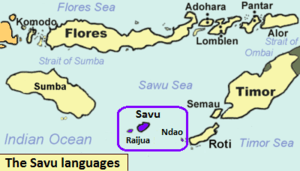Savu languages
| Savu | |
|---|---|
| Geographic distribution | Lesser Sunda Islands, Indonesia |
| Linguistic classification |
Unclear, perhaps Austronesian |
| Subdivisions | |
| Glottolog | hawu1234[1] |
 | |
The Savu languages, Hawu and Dhao, are spoken on Savu and Ndao Islands in East Nusa Tenggara, Indonesia.
Classification
Cappell (1975) noted a large amount of non-Austronesian vocabulary and grammatical features in the Central Malayo-Polynesian languages of East Nusa Tenggara and Maluku, notably in Hawu. While he generally spoke of a non-Austronesian substratum, Hawu is so divergent from Austronesian norms that he classified it (and Dhao) as a non-Austronesian language. He says,
Hawu also has a large AN [Austronesian] vocabulary, including the pronouns, and a couple of grammatical features, principally the stative prefix ma- and the causative pa- ... However, it contains no other AN grammatical features at all, and while being quite NAN [non-Austronesian], its grammar does not fall into line with the AT [Alor-Timor] languages, but is of an independent type. The right evaluation is therefore that Hawu is NAN, with a very heavy overlay of Indonesian AN vocabulary. (p. 683)
However, it is now generally accepted that Savu is no more divergent than the other Central Malayo-Polynesian languages, all of which display a non-Austronesian component that defines Melanesian languages.
Phonology
The Savu languages have the same vowels and stress rules. They share implosive (or perhaps pre-glottalized) consonants with the Bima–Sumba languages and with languages of Flores and Sulawesi further north, such Wolio, and languages of Flores such as Ngad'a have rather similar lengthening of consonants after schwa. Dhao has the larger inventory, but even where the languages have the same consonants, there is often not a one-to-one correspondence. Apart from Hawu /v/, Dhao is more conservative. Hawu *s, *c shifted to /h/ in historical times. Non-obvious correlations are:
| Dhao | Hawu | example | gloss |
|---|---|---|---|
| tʃ | h | tʃaʔe ~ haʔe | climb |
| s | h | risi ~ rihi | more |
| h | h | həba ~ həɓa | mouth |
| h | v | hahi ~ vavi | pig |
| ɖʐ | d | maɖʐe ~ made | dead |
| d | ɗ | məda ~ məɗa | niɡht |
| ɗ | ɗ | loɗo | sun, day |
| bβ | b | bβəni ~ bəni | woman |
| b | ɓ | həba ~ həɓa | mouth |
| ɓ | ɓ | saɓa ~ haɓa (?) | effort |
| #dʒ | #ʄ, #j | dʒaʔa ~ ʄaa / jaa | I, me |
| .dʒ | .dʒ | padʒuu ~ pedʒuu (?) | command |
| ʄ | ʄ | aʄu | tree |
For initial /dʒ/ in Dhao, there is dialectical variation between /ʄ/ and /j/ in Hawu. Most other consonants have a one-to-one correspondence, but a few (such as /ɓ/, /ɡ/, and non-initial /dʒ/) are not well-enough attested to be certain.
Pronouns
Independent personal pronouns are similar.
| Dhao | Hawu | |
|---|---|---|
| I | dʒaʔa | ʄaa (jaa, dʒoo) |
| thou | əu | əu (au, ou) |
| s/he | nəŋu | noo |
| we (incl) | əɖʐi | dii |
| we (excl) | dʒiʔi | ʄii |
| y'all | miu | muu |
| they | rəŋu | raa (naa) |
Parenthetical forms in Hawu are dialectical.
Footnotes
- ↑ Hammarström, Harald; Forkel, Robert; Haspelmath, Martin; Bank, Sebastian, eds. (2016). "Hawu–Dhao". Glottolog 2.7. Jena: Max Planck Institute for the Science of Human History.
References
- Grimes, Charles E. 2006. "Hawu and Dhao in eastern Indonesia: revisiting their relationship"
- Capell, Arthur. 'The "West Papuan Phylum": General, and Timor and Areas Further West', §2.10.1 in Wurm 1977 [1975], New Guinea Area Languages and Language Study, volume 1: Papuan Languages and the New Guinea Linguistic Scene. Canberra.